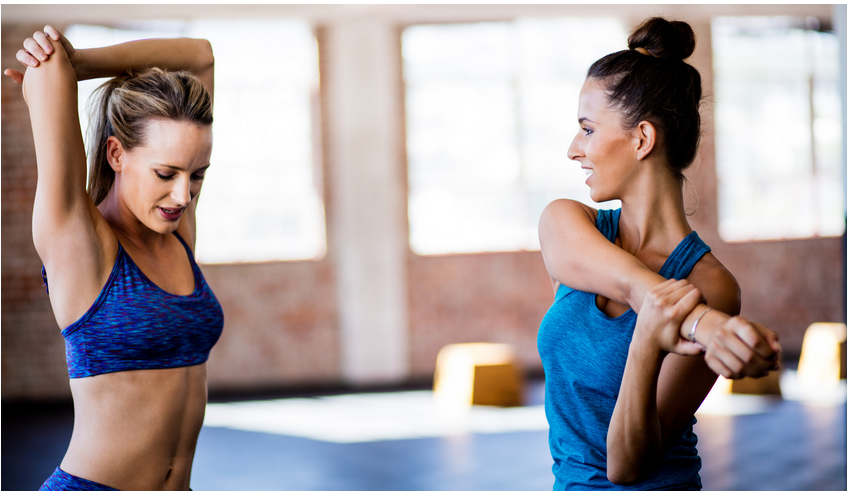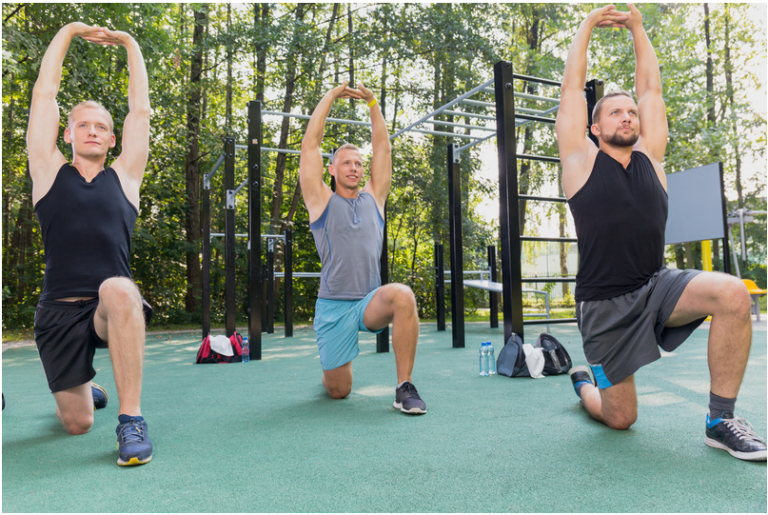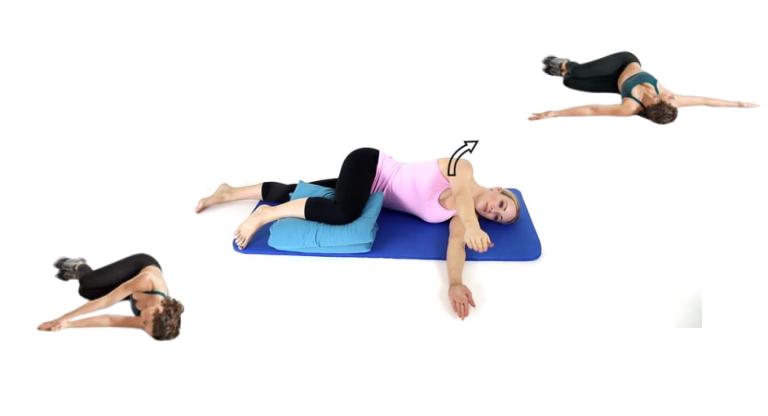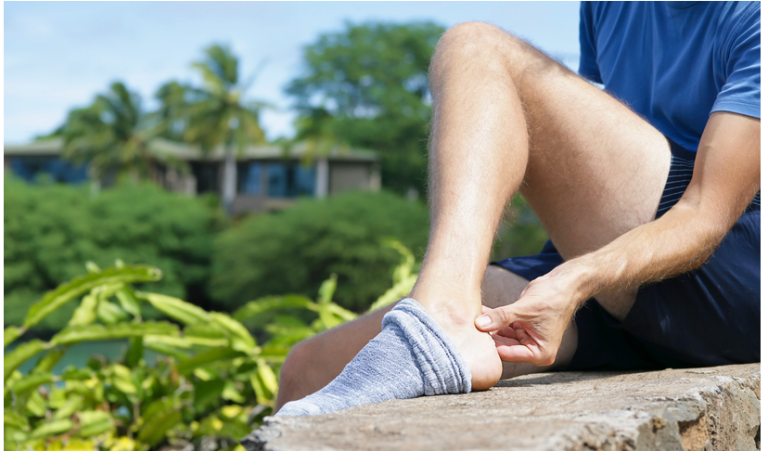
8 Best Deltoid Muscle Stretching Exercises for Quick Pain Relief!

We’ve all been there—those moments when our shoulders feel encased in cement after a long day at the desk or maybe pushing a bit too hard during that last workout. It’s almost as if our deltoid muscles are on strike, waving picket signs and chanting for immediate attention.
This is where the magic of deltoid muscle stretching exercises comes into play. Integrating these exercises into our routine can be a game-changer, offering our protesting deltoids the relief and attention they’ve been demanding.
As seasoned fitness guides who’ve journeyed through shoulder wellness with countless clients, we truly understand the importance of nurturing those feisty deltoids.
These muscles aren’t just another part of our anatomy; they’re critical players in reaching, lifting, and embracing life—literally! So, let’s give them some much-needed pampering.

Stretching is not only about easing tension; it’s a passport to new vistas of movement you may have never explored.
With the wisdom gleaned from years of helping others find solace for their sore shoulders, we’re excited to share strategies to make your stretches more effective and enjoyable.
Because really, shouldn’t life—and our shoulders—move as smoothly as butter on a sizzling skillet? Let’s get started on transforming those sighs into satisfied smiles!
Key Takeaways
- Stretching your deltoid muscles can improve flexibility, reduce injury risk, and boost performance.
- Key exercises to stretch the deltoids include Arm Across Chest Stretch, Standing Phelps Back Slap Stretch, and Sleeper Stretch.
- Follow correct steps when stretching to avoid mistakes like overstretching or not warming up.
- Make the stretches fit your fitness level by changing how hard or long you stretch.
- Include these stretches in your routine for strong and flexible shoulders.
Anatomy and Function of the Deltoid Muscles
The deltoid muscles and the rhomboids, trapezius, and rotator cuff play a crucial role in shoulder movement and stability. These muscles work together to facilitate various arm and shoulder joint movements.
Understanding their anatomy and function is essential for effective deltoid stretching exercises.
Main muscles involved (deltoid, rhomboids, trapezius, rotator cuff)
Our shoulders do a lot of work every day. It’s important to keep the muscles strong and flexible. Here’s a look at the main muscles that help our shoulders move:
- Deltoid: This muscle caps the shoulder, and focusing on it can reduce deltoid pain. It lets us lift our arms to the side, front, and back. We use it for throwing, lifting, and many daily tasks.
- Rhomboids: You’ll find these muscles between your shoulder blades. They help you pull your shoulders back and work hard when you squeeze your shoulder blades together.
- Trapezius: This large muscle goes from your neck to the middle of your back, supporting posture and movement that can stabilize the shoulder. It helps lift the shoulder blade, which is key when we raise our arms over our heads.
- Rotator Cuff: Four little muscles in this group are crucial for stabilizing the shoulder joint. They wrap around the shoulder joint to keep it steady as we move our arms.
How to do the anterior shoulder stretch?
To do the anterior shoulder stretch:
- Begin by standing upright with relaxed shoulders and back.
- Clasp your hands behind your lower back and lift them gently, ensuring that your elbows remain straight and away from your body.
- Maintain good posture throughout the stretch and avoid pushing yourself to the point of pain.
- Hold the stretch for 15 to 30 seconds; one stretch per session is sufficient.
Benefits of Stretching Your Deltoids
Stretching your deltoids can lead to improved flexibility, reduced risk of injury, and enhanced performance. So, let’s dive into these stretching exercises and see how they can benefit you!
Improved flexibility
We all want to move easily and without pain, right? Well, good news—stretching those deltoids can help with that. Imagine reaching up to grab something from a high shelf or swinging your arms freely while taking a brisk walk; these simple joys need flexible shoulders.
Let’s say you’ve been sitting at a desk all day, hunched over your computer (we’ve all been there). Your shoulders might feel tight and cranky. Enter deltoid stretches—they can rescue by loosening things up.
This way, your shoulder joints can dance through their full range of motion like nobody’s business! And guess what? A more bendy you mean fewer “ouch” moments when you’re going about your daily hustle—or just trying to impress friends with your killer jump shot on the basketball court.
Reduced risk of injury
Have you ever had that “oops” moment when you lifted something heavy, and your shoulder didn’t agree? Yeah, we get it. Stretching those deltoids can save us from those not-so-fun times.
Strong deltoids are like a security team for our shoulders; they keep everything stable and reduce the chances of getting hurt. And let’s be real; nobody likes being sidelined with an injury.
By taking a few minutes to stretch out our deltoid muscles every day, we’re giving them a helping hand. This means better support around the shoulder joint—and trust us, your shoulders will thank you! The more flexible and limber those muscles are, the less likely we’ll tweak something during our daily hustle or shooting hoops.
Let’s keep ourselves in the game by keeping those delts stretched and ready for action!
Enhanced performance
Stretching your deltoid muscles can help improve your range of motion, making lifting your arms and moving them in different directions easier. This can be especially helpful for athletes looking to enhance their performance.
By reducing muscle soreness and the risk of overuse injuries, static and dynamic stretching can significantly affect how well your deltoids function. This improved flexibility can also lead to better overall performance without causing any strength or performance deficits.
Static stretching increases the range of motion by decreasing musculotendinous stiffness, contributing to enhanced performance – a benefit that also comes from dynamic stretching as it improves dynamometer performance.
What are the 8 Deltoid Stretching Exercises to Relieve Shoulder Pain?
Ready to improve your shoulder flexibility, reduce the risk of injury, and feel a stretch across your chest? Try these eight deltoid stretching exercises to loosen tight muscles and enhance performance. Let’s dive in and get those shoulders feeling great, especially by focusing on posterior deltoid stretches for comprehensive shoulder care.
1. Arm Across Chest Stretch

The arm across-chest stretch is a great way to improve flexibility and range of motion in the shoulders. It’s one of the best deltoid stretches that can help mobilize and strengthen the shoulder muscles.
This exercise and other deltoid stretches can improve muscle extensibility and flexibility over time. According to physical therapists, including this stretch in your routine can help maintain flexibility and reduce arm muscle pain.
Remember: If you feel tightness or stiffness in your shoulders, these deltoid stretches may also benefit you!
2. Standing Micheal Phelps Back Slap Stretch

One of the dynamic stretches for your shoulders is the standing Micheal Phelps back slap stretch. It involves repeatedly swinging your arms across your body and opening the chest and shoulders.
This movement can help mobilize and strengthen your deltoids, enhancing shoulder mobility. Besides, it can be beneficial if you experience back pain or reduced range of motion in the lumbar region.
Incorporating this stretch into your routine may assist with pelvic angle issues and help relieve lower back discomfort. Moreover, focusing on these movements could improve flexibility while loosening up the tightness in various muscle groups, including deltoids and trapezius muscles.
3. Standing Alternating Upper Arm Circles

Let’s look at another great deltoid stretch – standing alternating upper arm circles, which can also incorporate triceps to strengthen and stabilize the shoulder. This exercise involves making circular motions with your arms in a standing position.
It helps to enhance flexibility and improve the range of motion in your shoulders. Engaging the deltoid muscles also aids in rotating the arms externally and internally, and can particularly focus on alleviating left shoulder discomfort.
Engaging in these dynamic shoulder stretches can help relieve tension and tightness in your shoulders, contributing to better shoulder mobility and flexibility. Remember that proper form is essential for effective stretching, so be mindful of maintaining good posture throughout the exercise.
4. Stick Pass Around Stretch

The Stick Pass Around Stretch is a great way to improve your shoulders’ flexibility and range of motion. It’s awesome for increasing shoulder muscle length and capsule mobility.
This stretch, included in a series of 8 deltoid stretching exercises, can help rehabilitate rotator cuff disease by strengthening the shoulder muscles and making them more mobile. It’s dynamic and targets the deltoid muscles effectively.
Incorporating the Stick Pass Around Stretch into your routine can enhance shoulder mobility while preventing injuries related to tight or stiff deltoids. By engaging in this stretch regularly, you’re actively working towards improving your overall shoulder health.
5. Standing Reverse Shoulder Stretch

When you do the standing reverse shoulder stretch, it helps to increase your shoulder flexibility and range of motion. It’s a great way to relax your deltoid muscles and give them some recovery time after working out.
This stretch is quite similar to the standing deltoid stretch and can benefit your shoulder muscles.
It’s a two-in-one deal because not only does this exercise help improve your flexibility, but it specifically targets deltoids that can get tight from daily activities or workouts.
6. Standing Wring the Towel

Standing Wring the Towel is a shoulder stretch that strengthens your deltoid muscles. You use a towel to stretch your shoulders, chest, and upper back. This exercise helps relieve tension in the neck and shoulders by targeting those specific areas using the resistance of the Towel, making it an effective way to ease shoulder pain.
It’s one of the best stretches for improving shoulder flexibility and mobility.
The Standing Wring the Towel exercise can benefit people experiencing tightness or pain in their deltoids. Incorporating this stretch into your routine can improve shoulder movement and alleviate discomfort in these muscle groups.
7. Doorway Shoulder Stretch

The doorway shoulder stretch is a great way to ease tension and enhance flexibility in our deltoid muscles. It specifically targets the front head of the three deltoid muscles, helping to open up our chest and relieve stress.
By using a doorway as support, this exercise can strengthen and loosen our shoulders, improving mobility and reducing tightness or pain. This static stretch is an effective method for increasing our shoulder muscles’ range of motion while promoting relaxation.
Remember that proper form is crucial. Ensure your hands are at or below shoulder height throughout the stretch to stabilize your shoulders effectively. Also, gently lean forward until you feel a good stretch – but don’t overdo it! This targeted exercise aids in enhancing both range of motion and muscle strength within your shoulders, helping to stabilize the shoulder joint.
8. Sleeper Stretch

We tried the sleeper stretch, and it helped with our shoulder flexibility. This exercise targets the infraspinatus muscle, which is key for improving the internal rotation of the shoulder.
Research has shown that this stretch can significantly increase posterior shoulder flexibility—it’s backed by science! Plus, studies have found that compared to other stretches, the sleeper stretch leads to less pain and discomfort.
So, if you want to boost your shoulder range of motion and minimize discomfort, try the sleeper stretch!
This exercise doesn’t only feel good; it also helps in real ways to stabilize the shoulder. It specifically focuses on enhancing your ability to move your shoulders comfortably without tension or pain. Incorporating the sleeper stretch into your routine could help open up the front of your body while reducing tightness and discomfort in those important deltoid muscles.
How to Properly Perform the Stretches
When stretching your shoulders, it’s important to do these exercises properly. Follow the step-by-step instructions to ensure you’re performing the stretches correctly. Additionally, be mindful of common mistakes that can hinder your progress.
Remember to approach the stretches gently, applying constant pressure without jerky motions. Avoid forcing the stretch beyond your comfort level, making sure to stay within a pain-free range of motion. By taking these safeguards, you can maximize the benefits of shoulder stretching while minimizing the risk of injury.
Here’s how to properly perform deltoid stretching exercises:
Step 1: Prepare for the Stretch
Before starting any deltoid stretch, preparing your body to avoid potential injuries is essential. Stand upright with your feet shoulder-width apart and engage your core muscles. Perform gentle arm circles or shoulder rolls to warm up your shoulder joints.
Step 2: Across-Body Deltoid Stretch
Execution
1. Raise your right arm across your body, parallel to the ground.
2. Use your left hand to gently pull your right arm towards your chest, feeling the stretch in your shoulder and deltoid muscle.
3. Hold the stretch for 10-30 seconds, breathing deeply.
4. Release and repeat the stretch on the opposite side, bringing your left arm across your body and using your right hand to assist the stretch.
Common Mistakes
- Avoid pulling your arm too forcefully, which can cause strain or injury.
- Keep your core engaged, and avoid arching your back during the stretch.
- Ensure your raised arm remains parallel to the ground throughout the stretch.
Step 3: Lateral Deltoid Stretch
Execution
1. Stand with your feet hip-width apart and raise both arms to your sides at shoulder height.
2. Roll your shoulders down and back, keeping your arms raised.
3. Hold the stretch for 10-30 seconds, breathing deeply.
Common Mistakes
- Avoid shrugging your shoulders up towards your ears.
- Keep your core engaged and maintain proper posture.
Step 4: Posterior Deltoid Stretch
Execution
1. Stand facing a wall and place one hand against it at shoulder height.
2. Slowly turn away from the wall, keeping your arm in place until you feel a gentle stretch in the back of your shoulder.
3. Hold the stretch for 10-30 seconds, breathing deeply.
4. Repeat the stretch on the opposite side.
Common Mistakes
- Avoid twisting your torso excessively during the stretch.
- Keep your core engaged and maintain proper posture.
Step 5: Resistance Band Deltoid Stretch
Execution
1. Secure a resistance band around a sturdy object at waist height.
2. Holding one end of the band in each hand, lift your arms overhead and slowly bring them down behind you until you feel a comfortable stretch in your deltoids.
3. Hold the stretch for 10-30 seconds, breathing deeply.
Common Mistakes
- Avoid arching your back excessively during the stretch.
- Keep your core engaged and maintain proper posture.
Step 6: Anterior Deltoid Stretch
Execution
1. Sit on a chair or bench with good posture and clasp your hands behind you.
2. Lift your arms slightly off your lower back while gently pulling them upward until you feel a mild stretch in the front of your shoulders.
3. Hold the stretch for 10-30 seconds, breathing deeply.
Common Mistakes
- Avoid rounding your shoulders forward during the stretch.
- Keep your core engaged and maintain proper posture.
Step 7: Doorway Deltoid Stretch
Execution
1. Stand facing an open doorway with both hands resting on the door frame at shoulder level.
2. Lean forward slightly until you feel a gentle stretch across the front of both shoulders.
3. Hold the stretch for 10-30 seconds, breathing deeply.
Common Mistakes
- Avoid leaning too far forward, which can cause strain or discomfort.
- Keep your core engaged and maintain proper posture.
Remember, proper form and technique are crucial to ensure the effectiveness and safety of these deltoid stretches. If you experience sharp pain or discomfort, discontinue the stretch and seek medical advice if necessary.
Modifications for Different Fitness Levels
Different people have different levels of flexibility and strength. So, it’s important to adapt the stretches according to your fitness level when doing deltoid muscle stretching exercises.
For those who are less flexible or have lower strength, starting with gentler variations of the stretches is okay. This can mean using less force when stretching or adjusting the range of motion.
On the other hand, individuals with higher flexibility and strength can go for more advanced variations of the deltoid stretches by increasing the intensity or duration of the stretch.
It’s crucial to remember that no matter your fitness level, gradual progression is key. Whether you’re a beginner or at an advanced level, always listen to your body and make adjustments as needed during your deltoid stretching routine, including across-your-chest stretches for balanced shoulder flexibility.
Conclusion
In conclusion, deltoid stretches offer numerous benefits for shoulder health and mobility. Incorporating these stretches into your routine can improve flexibility, reduce the risk of injuries, and enhance overall performance. Follow proper form and technique to maximize the effectiveness of these exercises.
Individuals who experience tightness or discomfort in the shoulder area due to physical activities, prolonged sitting, or poor posture may find relief through these stretches. However, if you experience persistent shoulder pain or stiffness, it is advisable to consult a medical professional or physical therapist for personalized guidance and treatment recommendations.
FAQs
How can one ensure that shoulder stretches are done gently and without causing pain?
To ensure that shoulder stretches are done gently and without causing pain, it is important to apply constant pressure during the stretches and avoid any sudden or forceful movements. Additionally, do not push the stretch beyond a comfortable range that leads to discomfort or pain.
What should individuals be cautious about when stretching their shoulders?
Individuals should avoid jerky motions and excessive force when stretching their shoulders. It is important not to push the stretch beyond a comfortable range that causes pain.
What is the recommended approach for performing shoulder stretches effectively?
The recommended approach for performing shoulder stretches effectively is to do them gently, with constant pressure, and without any jerky motions. Do not push the stretch beyond a comfortable range without feeling pain.
How should shoulder stretches be done to prevent injury?
Shoulder stretches should be done gently and with constant pressure to prevent injury. Avoid jerky motions, and do not force the stretch past where it is comfortable without pain.
What are some common mistakes to avoid when stretching your shoulders?
Do these stretches gently and with constant pressure rather than any jerky motions. Please do not force the stretch past where it is comfortable without pain.
What’s the big deal about stretching my deltoid muscles?
Oh, let me tell you—stretching those deltoids is key for keeping your shoulder movements smooth and pain-free! It can help loosen up any tightness and ease that annoying pain or stiffness you might feel after shooting hoops all day.
Can you give me a simple exercise to stretch my lateral deltoid?
Absolutely! Try this: stand tall (posture matters!), reach your right arm across your chest, and gently pull it closer with your left hand until you feel that sweet stretch on the side of your shoulder. That’s the spot for a posterior deltoid stretch!
I’ve got some serious tension in my shoulders; what should I do?
(You’re going to love this one!) Go for the dynamic bear hug stretch—it’s like giving yourself a big ol’ squeeze. Cross your arms over and open wide repeatedly as if hugging someone—it helps release all that built-up tension.
If I hurt my posterior deltoid, how can I safely stretch it?
Ouch—not fun! First, check with a doctor or physical therapist to play it safe—but once you get the green light, try reaching one arm straight behind you while seated or standing. This gentle move will nicely target that rear shoulder area.
When’s the best time to add these stretches into my routine?
Well, there isn’t exactly a “best” time; however, warming up before working out or taking breaks during long desk sessions could be perfect moments to fit in some good stretches for those delts!
Are these exercises only for when I’m sore from lifting weights?
No, siree—they’re not just for post-workout woes! Deltoid stretches are great anytime: they can improve range of motion whether you’ve been pumping iron… or want to shake off being stuck at a desk all day.



